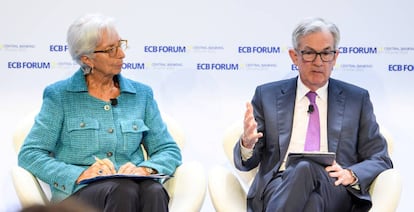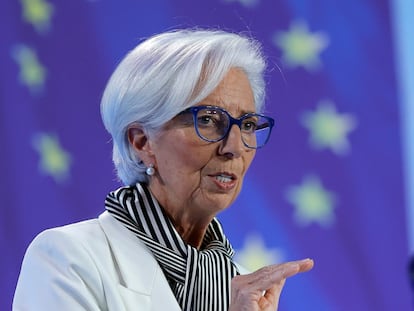Who will cut interest rates first: the Fed or the ECB?
Expectations for reductions have significantly cooled, but capital markets project the European Central Bank to act first and more aggressively throughout the year

A shift in the economic cycle is expected in 2024 that will lead central banks to embark on a program of interest rate cuts. The high expectations of capital markets were dampened by stubbornly persistent U.S. inflation data in January, and the Federal Reserve is not expected to make its first interest rate cut until June. But the European Central Bank (ECB) may beat the Fed to the punch with a rate cut in April, as it faces tighter constraints than the Fed. ECB President Christine Lagarde’s room for maneuvering is limited by time and the Eurozone’s economic fragility.
The slowing inflation towards the end of 2023 raised expectations that central banks might halt interest rate hikes and set the stage for a series of cuts. The new year began with the Fed leading investors to speculate about rate cuts as early as March, which would signal the ECB to follow. Inflation had decreased more in the eurozone, and high interest rates threatened to push European economies into a recession.
Amid investor excitement over a swift decline in interest rates this year, central banks worked to temper expectations, emphasizing the need to remain vigilant against inflation. But after last week’s U.S. inflation data for January revealed a greater-than-anticipated rise in prices, particularly in core inflation, investors resigned themselves to no Fed or ECB rate cuts in March. But the ECB doesn’t seem to want to wait on the sidelines for the Fed to act, and might proactively consider an initial rate cut as early as April.
“There is little evidence that the ECB will wait for the Fed,” said David Alexander Meier, an economist with Julius Baer. “Current economic data indicates increasing divergence, with U.S. data indicating delayed Fed rate cuts and eurozone data pressuring the ECB for earlier rate reductions.” In the U.S., prices grew in January by 3.1% annually and core inflation by 3.9%, while in the eurozone, inflation for the first month of the year stands at 2.8%. Regarding economic growth, the U.S. GDP increased by 3.3% in the fourth quarter of 2023 on an annualized basis, compared to the eurozone’s 0.1% annual growth, barely avoiding a technical recession.
The U.S. economy may not require an immediate rate cut, which is reflected in the futures market. Market expectations have shifted from anticipating six or seven rate cuts by the Fed in 2024, to now projecting only three or four. The total expected interest rate decrease for this year and next has dropped from 235 basis points a month ago to the current estimate of 165 basis points.
European futures now project an 83% chance of an ECB rate cut in June and 40.7% in April, down from 110% and 52% a month earlier. The Fed will likely be more conservative, so markets project a 65% chance of a cut in June and 31% in May. A month ago, there was an 80% likelihood of Powell cutting rates in May and 95% in June.
According to Alex Rohner of J. Safra Sarasin, “Eurozone data has slightly improved but still falls short of the recent strength shown by the U.S. economy. Inflation is declining faster in the eurozone than in the U.S., possibly enabling the eurozone to cut interest rates before the Fed.” ECB rate cuts could also be more aggressive than the Fed’s in 2024, noted Orla Garvey of Federated Hermes. “The ECB is expected to make more cuts this year than the Federal Reserve, with the Fed catching up in 2025.” Gilles Moëc, Chief Economist at Axa IM, shares this view. “The Fed has valid reasons for being cautious in its rate-cutting timeline. Market expectations indicate the ECB will cut rates more than the Fed by the end of 2024, reflecting the increasing divergence between the real [non-financial] economies of U.S. and the eurozone.”
The Fed has often acted before the ECB in the past. During the dot-com crash in 2000, it reduced rates five months before the ECB. In 2007, just before the 2008 financial crisis, the Fed cut rates over a year earlier than its European counterpart. The Fed also acted ahead of the ECB in March 2022, starting rate hikes to tackle post-pandemic inflation. This time, factors like lower inflation and Germany’s economic slowdown support those who believe the ECB may cut rates sooner and more aggressively than the Fed. Bank of America warned that if the ECB “postpones rate reductions, it could lead to expensive ramifications that may be hard to rectify through swifter reductions at a later time.”
Sign up for our weekly newsletter to get more English-language news coverage from EL PAÍS USA Edition
Tu suscripción se está usando en otro dispositivo
¿Quieres añadir otro usuario a tu suscripción?
Si continúas leyendo en este dispositivo, no se podrá leer en el otro.
FlechaTu suscripción se está usando en otro dispositivo y solo puedes acceder a EL PAÍS desde un dispositivo a la vez.
Si quieres compartir tu cuenta, cambia tu suscripción a la modalidad Premium, así podrás añadir otro usuario. Cada uno accederá con su propia cuenta de email, lo que os permitirá personalizar vuestra experiencia en EL PAÍS.
¿Tienes una suscripción de empresa? Accede aquí para contratar más cuentas.
En el caso de no saber quién está usando tu cuenta, te recomendamos cambiar tu contraseña aquí.
Si decides continuar compartiendo tu cuenta, este mensaje se mostrará en tu dispositivo y en el de la otra persona que está usando tu cuenta de forma indefinida, afectando a tu experiencia de lectura. Puedes consultar aquí los términos y condiciones de la suscripción digital.
More information
Archived In
Últimas noticias
Most viewed
- Reinhard Genzel, Nobel laureate in physics: ‘One-minute videos will never give you the truth’
- Oona Chaplin: ‘I told James Cameron that I was living in a treehouse and starting a permaculture project with a friend’
- Pablo Escobar’s hippos: A serious environmental problem, 40 years on
- Charles Dubouloz, mountaineering star, retires at 36 with a farewell tour inspired by Walter Bonatti
- Why we lost the habit of sleeping in two segments and how that changed our sense of time











































